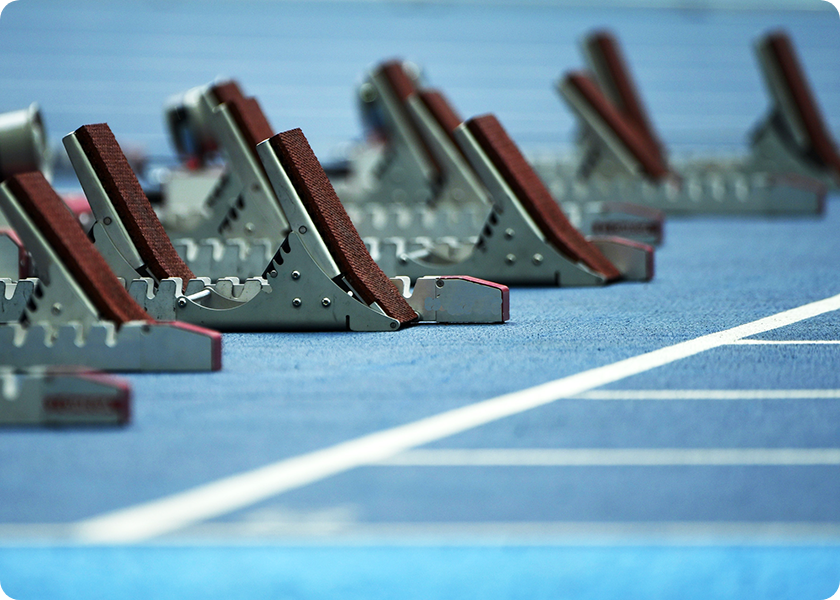World Athletics@TDK
[No.4 The Pole Vault] What is the pole vault?

- The origin of the pole vault is a technique contest to jump over obstacles with a wooden stick

- The introduction of a glass pole in the 1960s revolutionized the pole vault

- The pole vault jump has an element of gymnastics

- A large variety of LTCC products are developed by the co-sintering of different materials

- <A LTCC AiP device for 5G communication base stations>

The origin of the pole vault is a technique contest to jump over obstacles with a wooden stick
The pole vault is an event in which an athlete jumps over a high bar using a pole, which is classified as one of the jumping events in track and field athletics. However, since it involves a pole to aid the jump, unlike the high jump and other jumping events, it is termed as a vault and vaulter as opposed to a jump and jumper.
It originated in a technique contest to jump over a river or a fence with a stick. Initially, they used sticks of hickory, fir etc., so the records were two to three meters at best, approximately twice the jumper’s height. Later, the sticks were replaced with elastic, and after the sport was introduced to the Olympic Games, the record improved to beyond the four meter mark.
The world record in the pole vault had long been 6.14 meters held by Sergey Bubka in 1994, until Renaud Lavillenie broke it in 2014, exceeding it by 2 cm, clearing a height of 6.16 meters. This is almost as high as the roof of a two-story house. After glass fiber and carbon fiber were adopted, records in the pole vault significantly improved. That being said, a height of over six meters is rarely achieved. It is only when the potential power of the pole material is maximized by the athlete’s extraordinary physical abilities that a great vault of 6 meters and beyond can be accomplished.
The introduction of a glass pole in the 1960s revolutionized the pole vault
The pole vault was Japanese athletes’ forte in the first half of the twentieth century. Shuhei Nishida and Sueo Oe competed at the 1936 Berlin Olympics, and after hours of heated competition, they won the silver and bronze medals. It is well-known that upon their return to Japan they cut their medals in half and swapped the other halves of the medals, to honor each other’s best efforts in their performances. The poles they used were also made of bamboo. Metal poles were introduced afterward, but records remained at the level of four meters.
The world record in the pole vault had long been 6.14 meters held by Sergey Bubka in 1994, until Renaud Lavillenie broke it in 2014, exceeding it by 2 cm, clearing a height of 6.16 meters. This is almost as high as the roof of a two-story house. After glass fiber and carbon fiber were adopted, records in the pole vault significantly improved. That being said, a height of over six meters is rarely achieved. It is only when the potential power of the pole material is maximized by the athlete’s extraordinary physical abilities that a great vault of 6 meters and beyond can be accomplished.
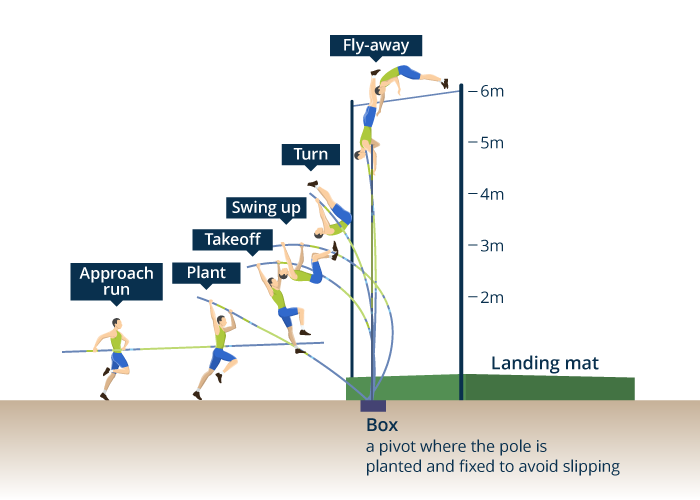
It was in the early years of the 1960s when the glass pole, made of fiberglass, was introduced which revolutionized the pole vault.
The material is called glass fiber, and materials using it are called glass fiber reinforced plastic (GFRP), these contain extremely fine fibers of glass set in thermosetting polymer or thermoplastic, which are then molded and hardened.
While bamboo is elastic, it will eventually snap if it is bent beyond a certain point. GFRP poles, by contrast, never break, even if bent 360 degrees. Their suppleness can be fine-tuned in the manufacturing process. Because of these attributes, GFRP was adopted as the best material for vaulting poles.
Thanks to this new material, the barrier of 16 feet (4.87 m), hitherto believed to be an unconquerable height, was broken in 1962 with the introduction of the glass pole, and the 5 meter mark was achieved subsequently in 1963. The record continued to grow, and finally in 1985, Bubka achieved a height of over 6 meters. No other track and field events made such remarkable progress in terms of records as the pole vault, owing to the advancement of equipment materials.
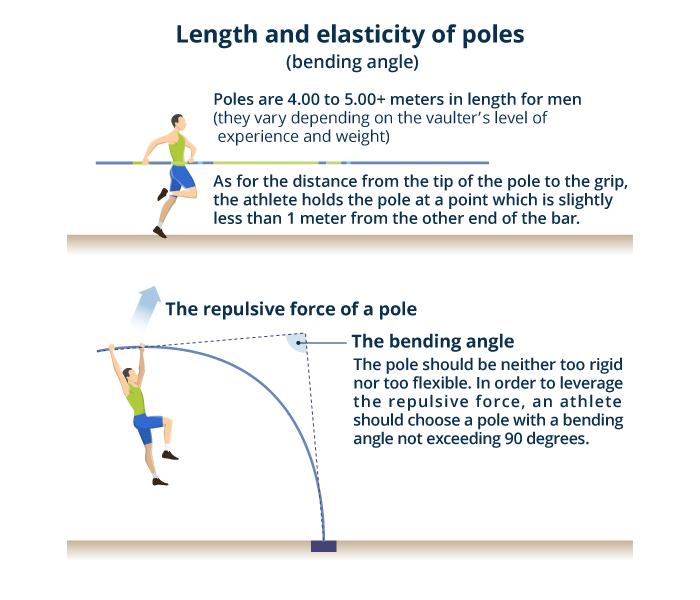
The pole vault jump has an element of gymnastics
In the pole vault, kinetic energy built up in the approach run is imparted to the flexible pole as the athlete takes off, then the vaulter uses the momentum from the repulsive force of the pole to lift their body upward, changing their body’s position upside down. During this phase the athlete hugs the pole tightly with their arms, with the body making an L shape, hence it is called the L position. From this L position, the vaulter twists their body with their arms extended, and going over the bar, they push back the pole as it returns into the original straight form. This is the sequence of actions of the pole vault.
As we can see in slow-motion images, the pole vault requires not only acceleration in the approach run and powerful takeoff, but also muscle strength in the arms, as well as maneuvering of the entire body, just like some technical elements in gymnastics. In fact, vaulters’ training includes sprinting and takeoff as well as the horizontal bar, flying rings, and trampoline.
A large variety of LTCC products are developed by the co-sintering of different materials
Some vaulting poles are made of carbon fiber reinforced plastic (CFRP). It is lighter and more elastic than metal, with high heat-resisting properties, and is often utilized in aerospace equipment.
When materials such as GFRP and CFRP are combined, it is called a compound material. For example, multilayer chip components, such as multilayer ceramic capacitors and multilayer inductors, are a combination of dielectric ceramics or ferrite and metal conductors. To create these high technology is required for the low temperature co-fired ceramic (LTCC) method that is used to manufacture high-frequency products and modules. This is a stacking method to embed many elements such as condensers, inductors, and filters, into multilayer boards in glass ceramics, with high density, for miniaturization and high performance.
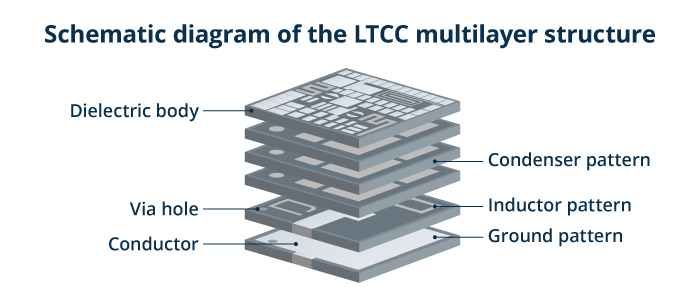
TDK’s is proud to have established and developed before anyone else LTCC technology to layer and co-sinter several sheets with different properties. This technology is called the co-sintering technology of different materials. For example, sheets with different permittivities are multilayered in high-frequency products and modules used for telecommunication devices, however this raises many problems. For example, different thermal expansion coefficients of dielectric sheets may result in warpage through sintering. TDK addressed this problem by introducing a technique of aligning the thermal expansion coefficients of dialectic sheets by adding minute amounts of additives.
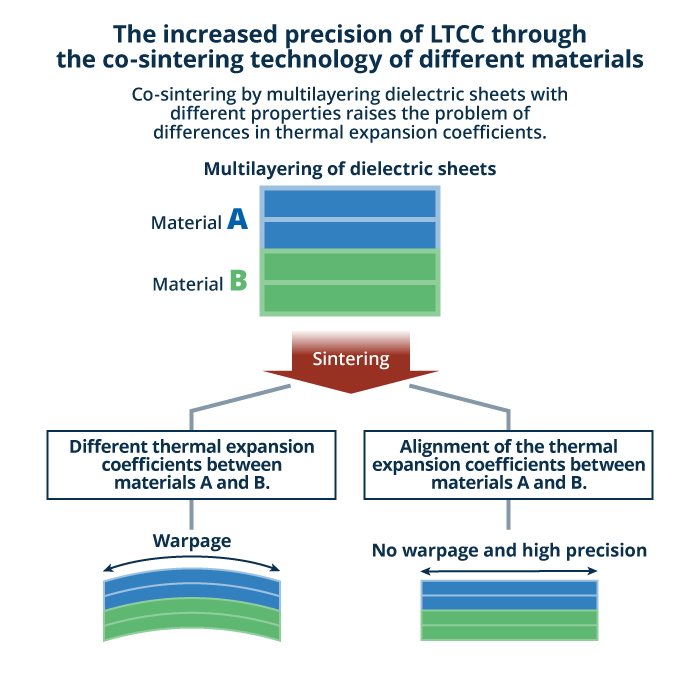
For wearable and IoT devices where multi-functionalization, high functionality, and miniaturization are required, the modularization of electronic components is expected to advance more in the future. TDK’s LTCC products are thus a result of leveraging its accumulated expertise in materials technology, fine multilayering technology, and high-frequency circuit technology. Leveraging the LTCC method, we have also developed a compound device in the antenna-in-package (AiP) configuration for ultrafast, large-capacity 5G communication.
<A LTCC AiP device for 5G communication base stations>

TDK’s LTCC AiP device is a compound device with antenna-in-package (AiP) configuration, in which circuits such as multiple antenna elements (4 x 4) and BPF are integrated into a LTCC multilayer board.
By adopting low-dielectric-constant LTCC materials, it realizes an excellent property of low loss in the millimeter waveband. It has excellent environmental resistance, thermal dissipation, and flexibility in design and evaluation, making this an ideal material for high-gain, high-directional array antennas for 5G communication base stations.
Chip Antennas
https://product.tdk.com/info/en/products/rf/rf/antenna/index.html
Deciplines
https://www.iaaf.org/disciplines/jumps/pole-vault
TDK is a comprehensive electronic components manufacturer leading the world in magnetic technology




